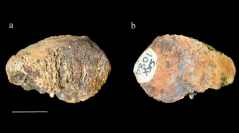

 Comptes Rendus Palevol
18 (2) - Pages 223-235
Comptes Rendus Palevol
18 (2) - Pages 223-235SKX 1084 is an isolated partial patella from Swartkrans Member 2, South Africa, attributed to a small-bodied Paranthropus robustus. This study provides complementary information on its outer conformation and, for the first time for a fossil hominin patella, documents its inner structure in the perspective of adding biomechanically-related evidence to clarify its identity. We used X-ray micro-tomography to investigate SKX 1084 and to extract homologous information from a sample of 12 recent human, one Neanderthal, and two adult Pan , patellae. We used geometric morphometrics to compare the outer equatorial contours. In SKX 1084, we identified two cancellous bony spots suitable for textural assessment (trabecular bone volume fraction, trabecular thickness, degree of anisotropy), and two related virtual slices for measuring the maximum cortico-trabecular thickness (CTT) of the articular surface. SKX 1084 shows a more complex articular shape than that for Pan, but still simpler than typical in Homo sapiens. At all sites, its CTT is thinner compared to Pan and approaches the condition in humans. This is also true for the expanded volume of the cancellous network. However, at both investigated spots, SKX 1084 is systematically intermediate between Homo and Pan for trabecular bone volume fraction and trabecular thickness, a pattern already shown in previous analyses on other Paranthropus postcranial remains. In the absence of any structural signal from patellae unambiguously sampling Paranthropus, as well as of comparable evidence extracted from specimens representing early Homo , our results do not allow rejection of the original taxonomic attribution of SKX 1084.
Fossil hominins, Knee joint, Cortical bone, Cancellous network, X-ray micro-tomography